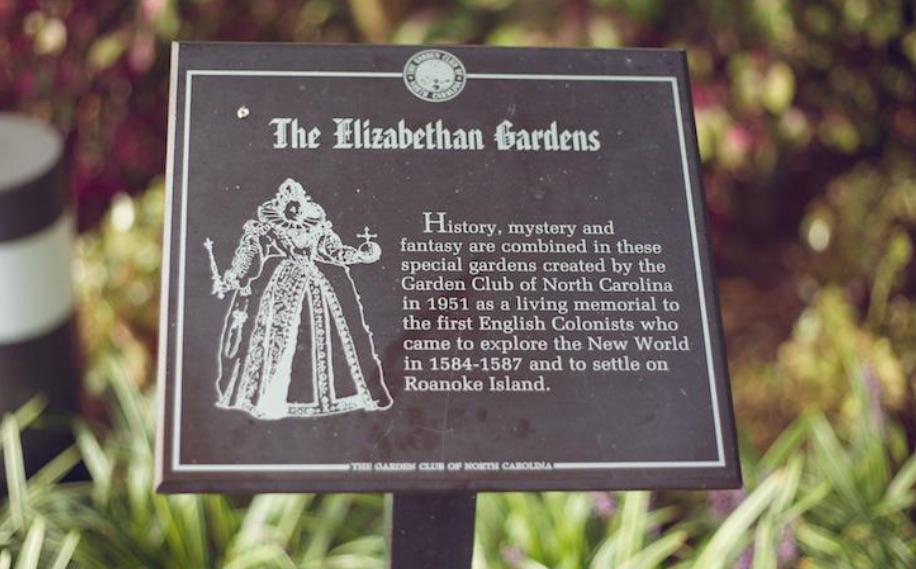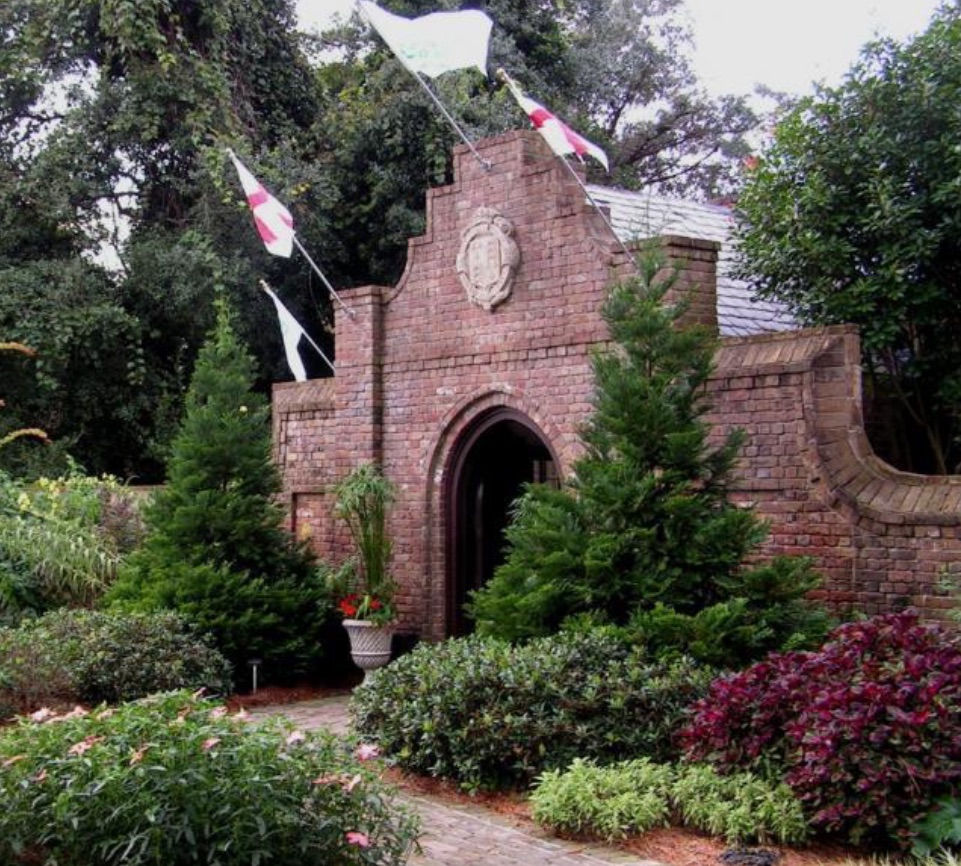A Visit to the Elizabethan Gardens
By Linda Puff, Fairfax Master Gardener
 It’s hot! It’s summer! It’s beach time! If your beach choice is the Outer Banks of North Carolina, please set aside some time to visit the Elizabethan Gardens. Just 15 minutes from Nags Head, north of Manteo and across the Manteo Causeway on Roanoke Island, the Gardens are located within Fort Raleigh National Historic Site, next to The Lost Colony.
It’s hot! It’s summer! It’s beach time! If your beach choice is the Outer Banks of North Carolina, please set aside some time to visit the Elizabethan Gardens. Just 15 minutes from Nags Head, north of Manteo and across the Manteo Causeway on Roanoke Island, the Gardens are located within Fort Raleigh National Historic Site, next to The Lost Colony.
In 1950, the Garden Club of North Carolina was asked to sponsor a 2 acre garden on 10 acres adjoining the Fort Raleigh National Park. At its annual meeting, the club voted to build a garden on the 2 acres as a memorial to Sir Walter Raleigh’s lost colonists. The garden was to resemble the kind of garden a colonist would have built on Roanoke Island had the colonization succeeded. The Garden Club set aside its original plan for the 2 acres when some valuable statuary became available. Architects were contacted and a more elaborate garden design was adopted for the entire 10 acres.
The construction began on June 2, 1953, the date Queen Elizabeth II was crowned Queen of England. The Gardens formally opened on August 18,1960, on the 373rd anniversary of the birth of Virginia Dare, the first child born in America of English parentage.
A Brief History
Roanoke Island is the site of the first English settlement in North America, established in 1585 to 1587, and sponsored by Sir Walter Raleigh representing Queen Elizabeth I. By 1590, no residents of the Lost Colony remained. The Elizabethan Gardens are a memorial to the valiant men and women, the English colonists, who came to Roanoke Island and became the Lost Colony.
 In August,1585, 22 years before Jamestown, 108 Englishmen, under the far-reaching hand of Sir Walter Raleigh, sailed into what is now called Roanoke Sound. They came ashore on an island called Roanoke in what is now Dare County in North Carolina. A safe harbor between the mainland and the Outer Banks, they chose an area covered with live oak as their first English colony in North America. This group later returned to England.
In August,1585, 22 years before Jamestown, 108 Englishmen, under the far-reaching hand of Sir Walter Raleigh, sailed into what is now called Roanoke Sound. They came ashore on an island called Roanoke in what is now Dare County in North Carolina. A safe harbor between the mainland and the Outer Banks, they chose an area covered with live oak as their first English colony in North America. This group later returned to England.
Two years later, a second ship of colonists was sent by Sir Walter Raleigh, and this trip included women and children. Several weeks after they arrived in July 1587, Virginia Dare was born. Ten days after the birth of his grandchild, John White, governor of the colony, returned to England for additional supplies. The colonists were left on their own. England was at war with Spain, which did not allow Governor White to immediately return with supplies. His return three years later in 1590 found no trace of the colonists.
Special Areas in the Gardens
This project is certainly one for all who visit to enjoy. It is a memorial to an earlier time, but is filled with beautiful plants, trees and shrubs and events and activities for the entire family.

Gazebo
A main feature is the Sunken Garden. This square area has 32 identical parterres outlined in clipped dwarf yaupon (Ilex vomitoria). The area is a continuing parade of color with the ever-changing display of ornamental plants. Thousands of annuals, perennials, hybrids and day lilies are on display. The pansies welcome spring, followed in the summer by ageratum, vinca and begonias, all complementing the crepe myrtles. One hundred and twenty-five species of camellias encircle the Great Lawn. Among the live oaks is one ancient live oak that is believed to have been alive in 1585 when the colonists arrived on Roanoke Island.
In 1976, the Queen’s Rose Garden honoring H.M. Queen Elizabeth II was designed. Three sides are brick walls and the fourth is a mass of azaleas. Sculptures, a marble bench and a 500-year-old sundial are part of the Rose Garden. Grandiflora, hybrids, tea and floribunda roses in varying hues from pink to orange to red fill the beds. Salmon-pink climbers drape the walls and pink shrub roses are at the base. Snuggled in among these roses is a rose bush sent by Queen Elizabeth, from the rose garden at Windsor Castle. This garden was dedicated in the Queen’s honor in September,1976. Cultivated in 1998, the Virginia Dare rose, a compact bush of rich green foliage that blooms profusely, was added to the garden.
These Gardens are family gardens. Visitors can bring a picnic to enjoy on the Great Lawn. Pets are also welcomed. Some of the activities include yoga in the garden, tea with the Queen, floral arranging, fun with frogs and a butterfly release.
Children as well as parents can enjoy the Discovery Cottage and the John White Butterfly Center, named for the governor of the colony. The Discovery Cottage area has an indoor classroom where summer programs are held. An outdoor play area offers a large play ship that resembles the ship that carried the colonists to the New World. There are swings, slides, a koi pond, a fossil pit and more to entertain and educate children.
The Butterfly Center is a new addition where guests can walk through the indoor greenhouse that houses butterflies from May through September. The center was created to educate the public on the plight of Monarchs and on milkweed, the plant the Monarch feeds on exclusively. The Center planted a quarter acre of nectar producing plants, enticing 15 of the state’s most common butterflies. Monarchs are the star attraction, but swallowtails, fritillaries, painted ladies and skippers flit around as well. Each has its own personality. Visitors on a Wednesday are invited to open a container to let fly a grown butterfly.
Courtyards, brick paths, crisp hedges and the fragrant herbs in Shakespeare’s Herb Garden transported me to the Elizabethan world. A tranquil visit at my own pace made for a most enjoyable few hours: to be a part of history, see an array of beautiful plants and learn as I strolled the paths of the Elizabethan Gardens.
Resource
Elizabethan Gardens, Manteo, North Carolina